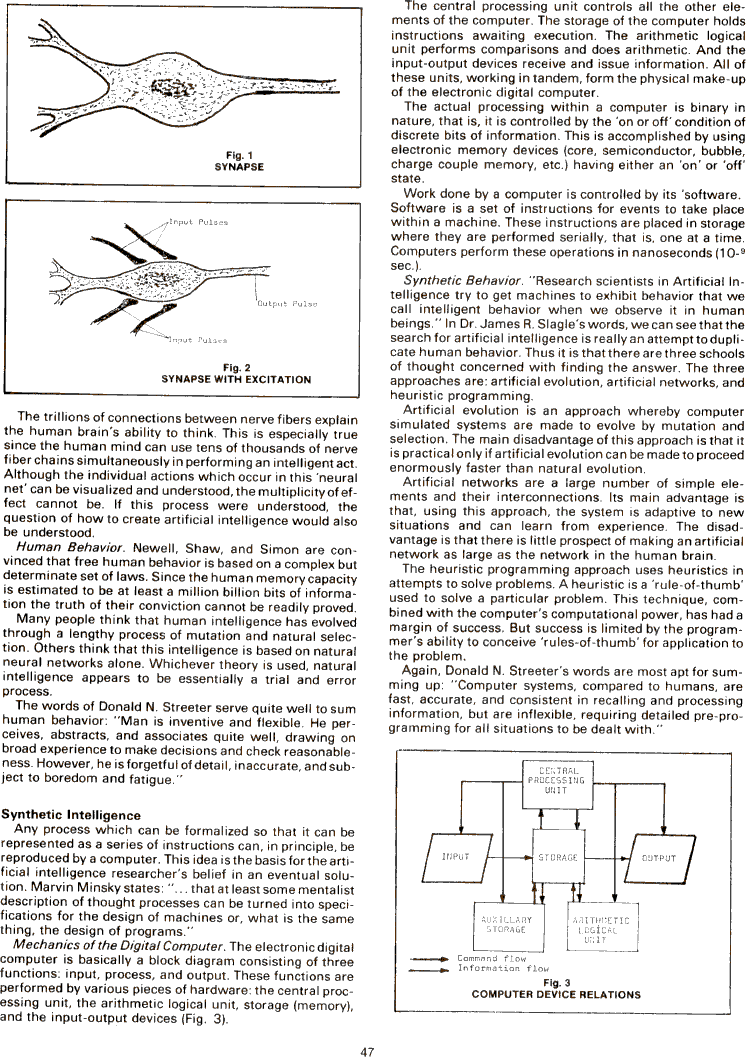The Best of Creative Computing Volume 2 (published 1977)
Primer on Artificial Intelligence (synthetic intelligence and behavior)

The trillions of connections between nerve fibers explain the human brain's
ability to think. This is especially true since the human mind can use tens of
thousands of nerve fiber chains simultaneously in performing an intelligent act.
Although the individual actions which occur in this 'neural net' can be
visualized and understood, the multiplicity of effect cannot be. lf this process
were understood, the question of how to create artificial intelligence would
also be understood.
Human Behavior. Newell, Shaw, and Simon are convinced that free human behavior
is based on a complex but determinate set of laws. Since the human memory
capacity is estimated to be at least a million billion bits of information the
truth of their conviction cannot be readily proved.
Many people think that human intelligence has evolved through a lengthy
process of mutation and natural selection. Others think that this intelligence
is based on natural neural networks alone. Whichever theory is used, natural
intelligence appears to be essentially a trial and error process.
The words of Donald N. Streeter serve quite well to sum human behavior: "Man
is inventive and flexible. He perceives, abstracts, and associates quite well,
drawing on broad experience to make decisions and check reasonableness. However,
he is forgetful of detail, inaccurate, and subject to boredom and fatigue."
Synthetic Intelligence
Any process which can be formalized so that it can be represented as a series
of instructions can, in principle, be reproduced by a computer. This idea is the
basis for the artificial intelligence researcher's belief in an eventual
solution. Marvin Minsky states: " … that at least some mentalist description
of thought processes can be turned into specifications for the design of
machines or, what is the same thing, the design of programs."
Mechanics of the Digital Computer. The electronic digital computer is
basically a block diagram consisting of three functions: input, process, and
output. These functions are performed by various pieces of hardware: the central
processing unit, the arithmetic logical unit, storage (memory), and the
input-output devices (Fig. 3).
The central processing unit controls all the other elements of the computer.
The storage of the computer holds instructions awaiting execution. The
arithmetic logical unit performs comparisons and does arithmetic. And the
input-output devices receive and issue information. All of these units, working
in tandem, form the physical make-up of the electronic digital computer.
The actual processing within a computer is binary in nature, that is, it is
controlled by the 'on or off ' condition of discrete bits of information. This
is accomplished by using electronic memory devices (core, semiconductor, bubble,
charge couple memory, etc.) having either an 'on' or 'off' state.
Work done by a computer is controlled by its software. Software is a set of
instructions for events to take place within a machine. These instructions are
placed in storage where they are performed serially, that is, one at a time.
Computers perform these operations in nanoseconds (10-9 sec.)
Synthetic Behavior. "Research scientists in Artificial Intelligence try to get
machines to exhibit behavior that we call intelligent behavior when we observe
it in human beings." In Dr. James R. Slagle's words, we can see that the search
for artificial intelligence is really an attempt to duplicate human behavior.
Thus it is that there are three schools of thought concerned with finding the
answer. The three approaches are: artificial evolution, artificial networks, and
heuristic programming.
Artificial evolution is an approach whereby computer simulated systems are
made to evolve by mutation and selection. The main disadvantage of this approach
is that it is practical only if artificial evolution can be made to proceed
enormously faster than natural evolution.
Artificial networks are a large number of simple elements and their
interconnections. Its main advantage is that, using this approach, the system is
adaptive to new situations and can learn from experience. The disadvantage is
that there is little prospect of making an artificial network as large as the
network in the human brain.
The heuristic programming approach uses heuristics in attempts to solve
problems, A heuristic is a 'rule-of-thumb' used to solve a particular problem.
This technique, combined with the computer's computational power, has had a
margin of success. But success is limited by the programmer's ability to
conceive 'rules-of-thumb' for application to the problem.
Again, Donald N. Streeter's words are most apt for summing up: "Computer
Systems compared to humans are fast, accurate, and consistent in recalling and
processing information, but are inflexible, requiring detailed pre-programming
for all situations to be dealt with."


